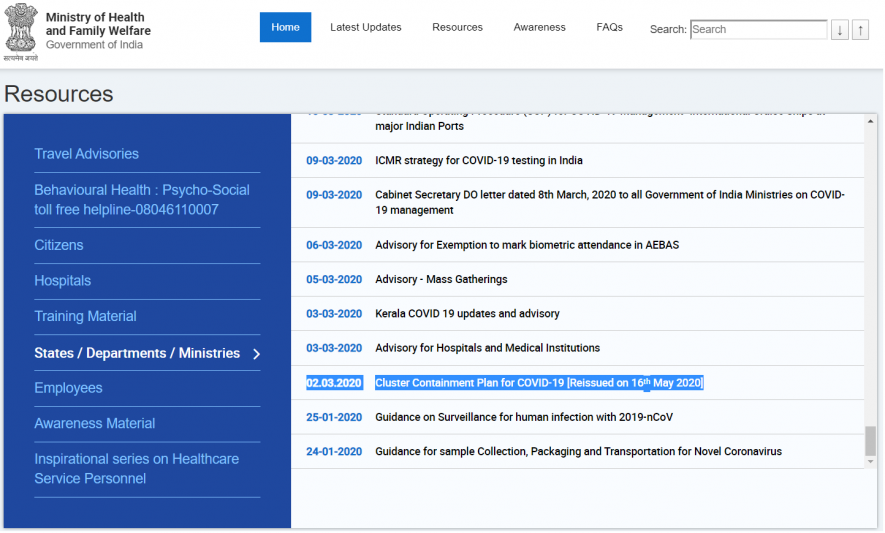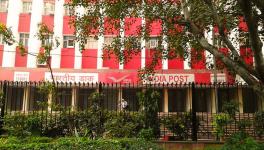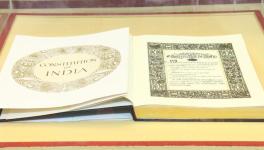For Over a Month, Modi Govt Didn’t Adhere to NDMA Advisory on COVID-19

Representational image. | Image Courtesy: The Print
Did the Narendra Modi bypass the NDMA’s advice on COVID-19 till the spread of the virus went out of hand? The sequence of events would suggest so.
On February 4, the National Disaster Management Authority (NDMA) has issued its first guideline on travel, hygiene, avoiding crowd contact and use of hand sanitisers and masks to prevent the spread of novel coronavirus.
Yet, on February 24, US president Donald Trump was hosted in Gujarat by Prime Minister Modi amid fanfare, without adhering to the NDMA guidelines. It was claimed that more than one lakh people attended the event. Interestingly, Modi himself is chairman of NDMA.
On January 25, P K Mishra, principal secretary to the Prime Minister, chaired a high-level meeting on the coronavirus outbreak with officials of Ministry of Health and Family Welfare (MoHFW). On the same day, the Health Ministry put out a detailed guidance document for “POEs, states and UTs (Union Territories) for surveillance of 2019-nCoV.”
The ministry’s guidelines included the screening of incoming passengers from the affected countries, establishment of in-country/community surveillance through the Integrated Disease Surveillance Programme network (IDSP), community-based contact tracing implementations and advisory for symptomatic and asymptomatic contacts.
Importantly, the advisory clearly stated that “the (incoming) passenger (from the affected countries) has to be observed from 28 days from the day of possible exposure/arrival to India.” And it asked the tracing health workers to keep a two-meter distance from the contact and use face masks.
Starting January 17, the Health Ministry issued seven travel advisories till March 3. Most of these asked people to be cautious while travelling to China. It issued visa restrictions for nationals from affected countries, starting from China and later included South Korea, Iran, Italy and Japan.
On January 24, the Indian Council for Medical Research (ICMR), too, issued guidelines for sample collection, packaging and transportation for COVID-19 testing.
On 25 January, the Health Ministry issued guidance on surveillance for human infection of 2019-nCoV. It advised states to observe passengers coming from China for 28 days and asked to isolate them to medical facilities if they develop any symptoms as also trace the contact of that individual for observation.
On January 30, the World Health Organisation (WHO) declared the COVID-19 outbreak as a “Public Health Emergency of International Concern” (PHEIC).
On the same day, the first COVID-19 positive case in India was reported in Kerala of a student who had returned from China. By February 2, following the guidance document of the Health Ministry, Kerala identified 2,239 travellers from China and other affected countries and placed them under surveillance. On February 3, the government of Kerala issued a state calamity warning.
On the same day, February 3, a meeting of the Group of Ministers took place in Delhi to discuss the measures taken to control the spread of the virus in India. In the meeting, it was disclosed that a total of 593 flights from the affected countries had been screened in 21 airports, sea ports and borders with neighbouring countries, covering a total of 72,353 passengers since January 18.
However, during this time period, India was screening incoming passengers only from China and Hong Kong. A travel advisory published by the Health Ministry on January 25, states that Macao, Taiwan, Japan, South Korea, United States, Vietnam, Singapore, Nepal France also had reported coronavirus infections.
The website Fact Checker pointed out that Australia, Malaysia, Canada, Cambodia, Sri Lanka, Germany, the UAE, Taiwan, Finland, Angola, Italy and Spain had also reported COVID-19 positive cases. But, incoming passengers from these countries were not subjected to screening in India.
On February 5, Eurosurveillance, a journal on infectious disease surveillance, epidemiology, prevention and control, published a study by The London School of Hygiene & Tropical Medicine (LSHTM) that said that screening at airports would not be effective in identifying passengers infected with the virus due to various factors, including the incubation period.
Much before that, on January 24, a WHO statement said “evidence shows that temperature screening to detect potential suspect cases at entry may miss travellers incubating the disease or travellers concealing fever during travel and may require substantial investments. However, during the current outbreak with the novel coronavirus 2019-nCoV, the majority of exported cases were detected through entry screening. The risk of importation of the disease may be reduced if temperature screening at entry is associated with early detection of symptomatic passengers and their referral for medical follow up.”
On February 4, NDMA, under the Home Ministry, sent an advisory, signed by member secretary S V V Sharma, IAS, to the chief secretaries of all sates and Union Territories. It was mentioned that there was a meeting between the cabinet secretary and (Health Ministry) in which it was decided to ask the relevant agencies of all states and UTs to take “important actions” pertaining to novel coronavirus outbreak.
Out of the eight points mentioned in the advisory, two were very important: “Extensive coverage on social media and print and electronic media on do's and don'ts issued by MoHFW on social media/Press Information Bureau/MoHFW website and also ensure translation/dissemination in local languages” And “Promote advisories on travel, hygiene, avoiding crowd contact; quarantine of people arriving from countries notified by MoHFW, use of personal protective equipment (masks, hand sanitizers usage); isolation of patients.”
Recall, that the Delhi Assembly election was just around the corner then. PM Modi held an election rally in Delhi on February 4. Uttar Pradesh chief minister Adityanath held two rallies -- in Patparganj and Shahdara -- on the same day, and Home Minister Amit Shah, under whom the NDMA functions, held four rallies each on February 4 and 5. The then Health Minister J P Nadda held three election rallies on February 5. Many other Union ministers, chief ministers of ruling Bharatiya Janata Party/ National Democratic Alliance-ruled states and senior BJP leaders and functionaries spoke in scores of rallies organised by the party from February 4 to the end of the campaign at 5 PM on February 6.
So, for obvious reasons, the Central government did not take any initiative to publicise the do's and don'ts, which included avoiding crowd contact, use of masks and hand sanitisers etc., issued by the Health Ministry.
The Health Ministry’s first awareness material was released after a month, on March 6.
Meanwhile, the first part of the budget session of Parliament went on from January 31 and till February 11. On February 24, a mega event and road show was organised by the government in Ahmedabad to welcome Trump. The government claims that more than one lakh people gathered in the stadium.
The Parliament session, which had taken a break, restarted on March 2. On the same day, the Health Ministry put out the “Cluster Containment Plan for COVID-19”. (This file is not available on the MoHFW website. It shows the same circular has been re-issued on May 16 and that file is a revised one.)

On March 3, the Health Ministry said: “The medical infrastructure in the country needs to be prepared for any possible influx of patients on account of COVID 19.” It asked hospitals to postpone all non-essential elective surgeries and prepare and set apart “some beds” for creating isolation facilities in every public and private hospital in every state and UT, mobilise additional resources including masks, gloves and personal protection equipment (PPE), train all doctors, nurses and support staff in different specialties of all departments in infection prevention and control practices, procure sufficient numbers of ventilators and high flow oxygen masks, to assure the availability of adequate trained manpower and resource pools for ventilator/ ICU care, and to discharge all the stable patients “as early as possible” and to restrict new admissions of stable patients. Hospitals were given time till March 31, to implement these instructions.
On March 5, the NDMA issued another advisory to chief secretaries of all states and UTs on Steps to be taken regarding Coronavirus (COVIO-19). Among many other things, it suggested: “If necessary to issue the directive to avoid public gathering in confined spaces as much as possible. Mass gatherings may be rescheduled or postponed and held after adequate risk assessment. Widely propagate strategy of social distancing and personal hygiene. Awareness campaigns in schools, may be started immediately. A decision on temporary school closures may be taken by the State/UT administration after risk assessment.” On that date, India had 30 confirmed COVID-19 positive cases.
On March 5, the Health Ministry put out an Office Memorandum (advisory) for health secretaries of all states and UTs to avoid mass gatherings and postpone all planned mass gathering events till the spread of the disease was contained. If any such mass gatherings are organised, it advised states to take necessary action to advise the organisers to take adequate precautionary measures and avoid people with Severe Acute Respiratory Illness (SARI) and Influenza like illness.
These advisories show that the Health Ministry was clearly aware that the virus was spreading more than anticipated. But the Central and state governments seem to have taken this information lightly. Religious functions were not stopped and temples were crowded every day, mosques on Fridays and churches on Sundays.
In Delhi, a Sunni Islamic movement, called Tablighi Jamaat, held various religious congregations in the closed premises of its headquarters, starting the first week of March. The health secretary of Delhi would also have received these advisories from the Health Minstry and NDMA. However, the Delhi government’s first order on public gathering -- sports activities, seminars, conferences and other events which are in nature of public gathering – was issued only on March 13.
In the second week of March, the BJP was busy orchestrating the fall of the Congress-led government in Madhya Pradesh. On March 10, Congress leader Jyotiraditya Scindia met PM Modi and Home Minister Amit Shah and few hours later announced his resignation from the Congress. Soon after, Scindia’s loyalists in the state unit – 19 Congress MLAs including six ministers -- sent their resignation letters, reducing the government to a minority.
Scindia joined BJP on March 11. On March 12, BJP organised a grand welcome for him in Bhopal. Thousands of BJP workers and most of the state BJP leaders, including the current chief minister Shivraj Singh Chouhan, were gathered greet the new entrant to the party.
After issuing many circulars, warnings and alerts on March 13, the Health Ministry said the coronavirus was not a health emergency and people shouldn’t worry. The Parliament session was still on. On March 18, some Rajya Sabha members attended the session wearing face masks. The House chairman, Vice president Venkaiah Naidu, objected to this and asked the members to remove the masks or face the action!
Then, on March 19, Modi addressed the nation and said: "The world is passing through a huge crisis. This crisis has engulfed the entire human race. For the past two months, we have been watching with concern the news about coronavirus spreading across the world…. Usually, when a natural crisis comes, it is limited to some countries. But this time, this outbreak has put all in danger," showing he was clearly aware and updated about the spread of the virus in India.
Instead of speaking about the actions the government was planning to take to control the spread of the virus, Modi asked people to come out on their balconies at 5 PM on March 22 and clap/clang utensils to appreciate the efforts of the healthcare fraternity.
Meanwhile, in Madhya Pradesh, the governor asked the Kamal Nath government to prove its majority on the floor of the House on March 20. Just few hours before the floor test, Kamal Nath resigned and BJP leader Shivraj Singh Chouhan took oath as the Chief Minister of Madhya Pradesh. A few hours later, the Modi government adjourned Lok Sabha sine die, ending the Parliament session.
At 8 PM on March 24, Modi again addressed the nation and announced that the country will be locked down completely in four hours time for two weeks.
The chronology of events clearly shows that the Modi government had all the information that the virus was spreading across the country. The Health Ministry and NDMA issued warnings and advisories in February first week itself. By March first week, the picture around the world was clear. But, instead of taking precautionary measures, the Modi government preferred to be led by political considerations. The rest is history.
Available information in public domain shows that Kerala was the only state which acted upon few of the suggestions mentioned in the two important circulars of NDMA. The state started the contact tracing, home quarantine of the contacts and social media campaign by February first week itself.
With inputs from Commodore Lokesh Batra (retired)
Get the latest reports & analysis with people's perspective on Protests, movements & deep analytical videos, discussions of the current affairs in your Telegram app. Subscribe to NewsClick's Telegram channel & get Real-Time updates on stories, as they get published on our website.
























